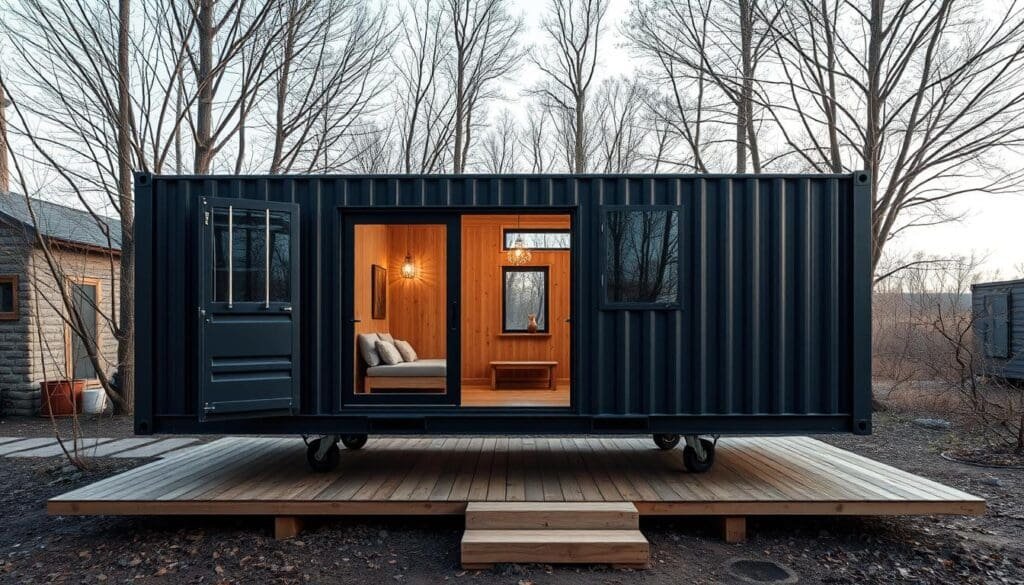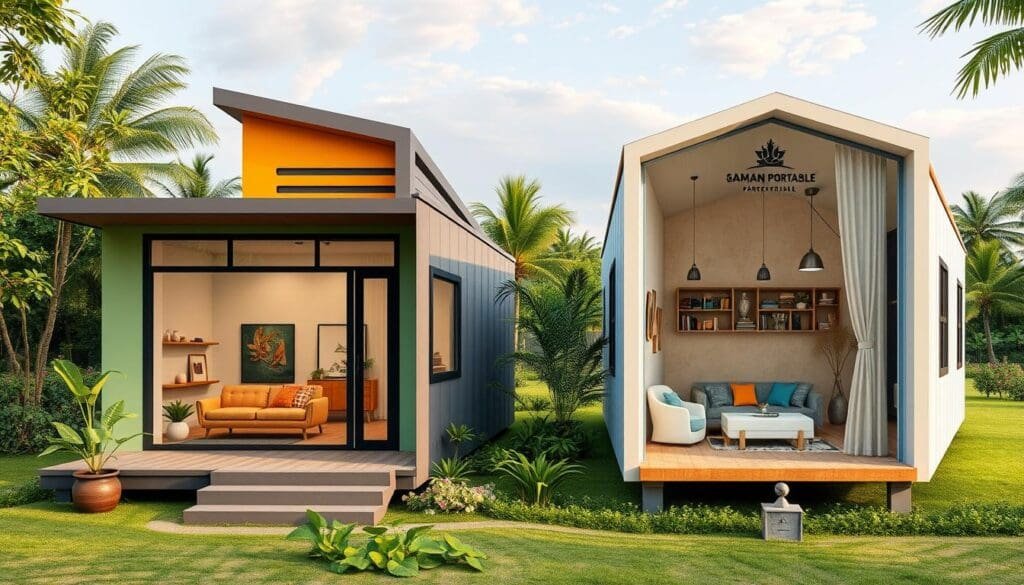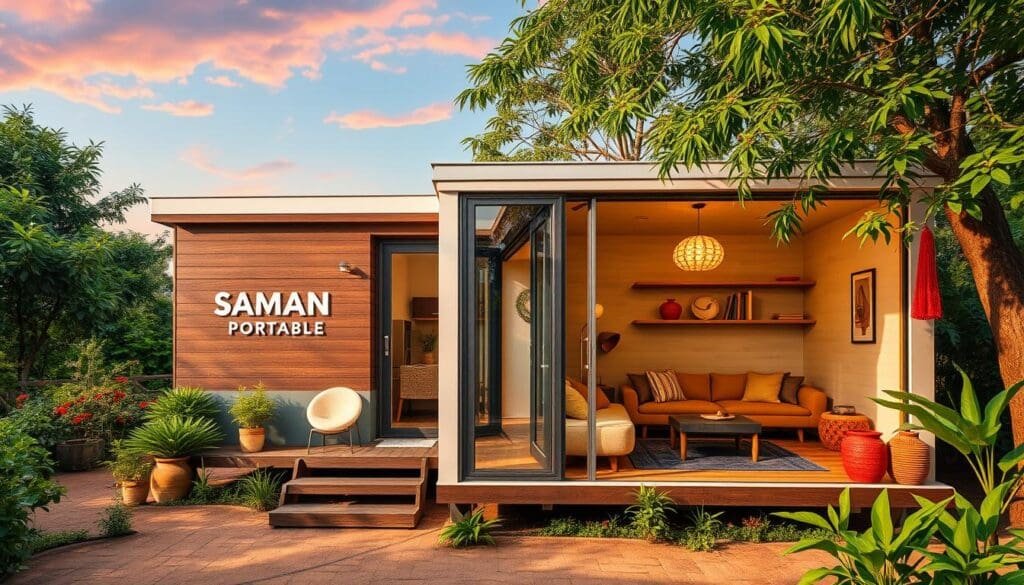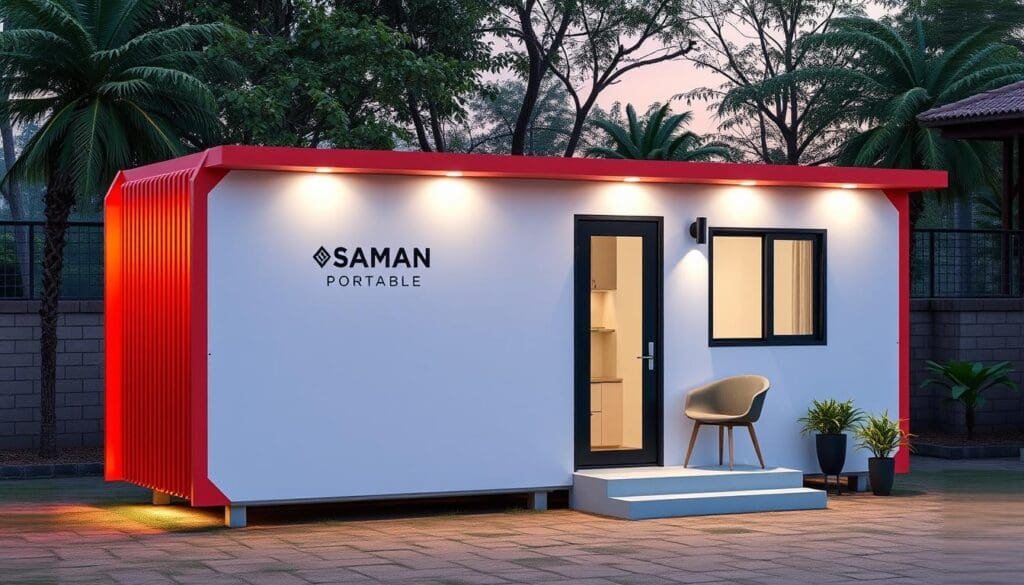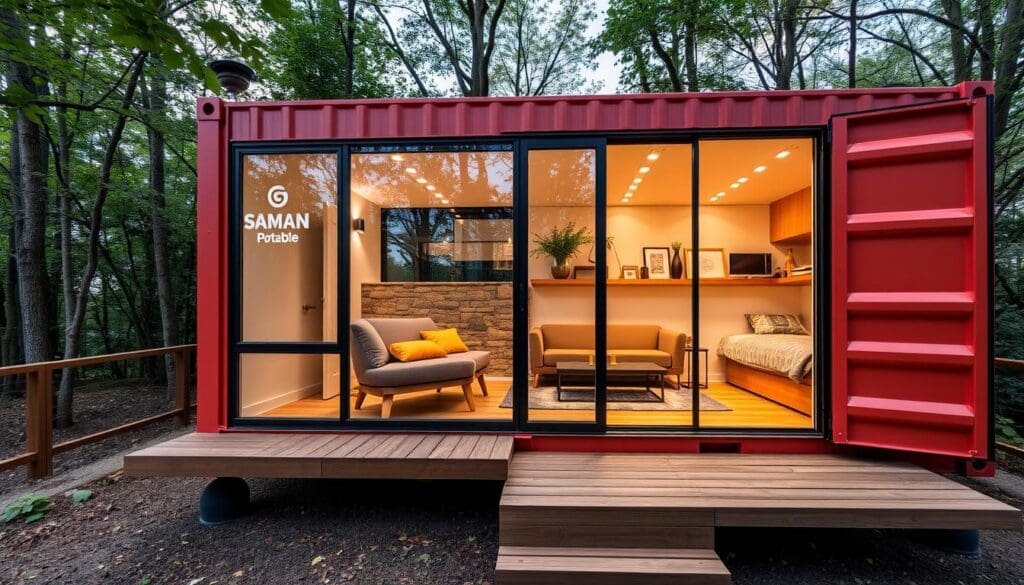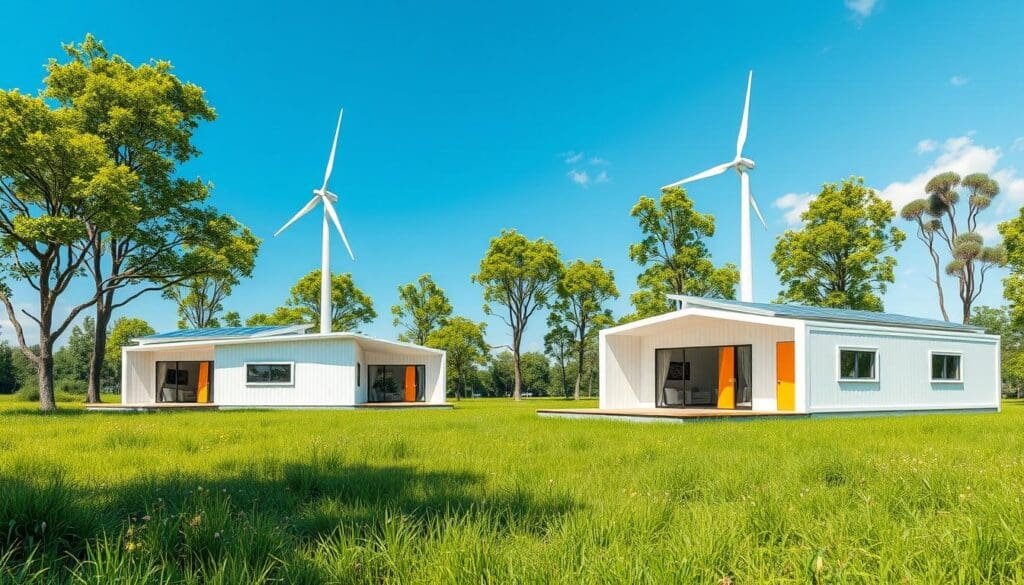Portable Cabin Solutions: Your Guide to Modular, Affordable, and Sustainable Spaces
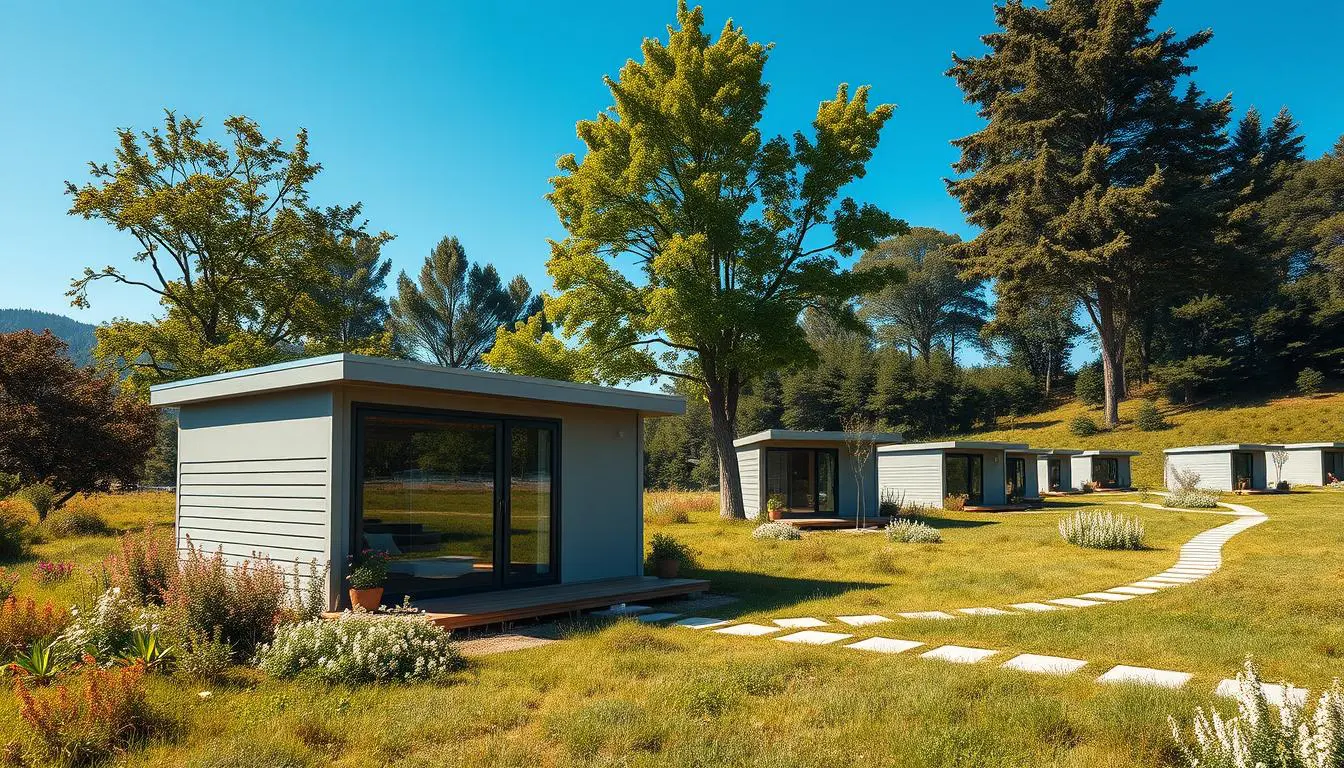
In today’s fast-changing business world, can portable cabin solutions solve your space problems? These innovative, prefabricated structures are changing the game. They offer businesses a flexible and green way to meet their needs. But what sets portable cabins apart, and how can they change your workspace? Let’s find out.
Looking for a ready-made solution? Our portable cabin product line offers pre-built options for quick and hassle-free setup. Choose from durable, stylish designs tailored to your needs.
Key Takeaways
- Portable cabins are a cost-effective and flexible solution for many business needs, from construction sites to remote healthcare facilities.
- These prefabricated structures are made with durable materials and advanced techniques, ensuring they last a long time.
- Portable cabins can be customized to fit specific needs, making them great for many sectors and uses.
- They can be set up quickly and moved easily, perfect for emergencies and changing business needs.
- With features like energy-efficient design and eco-friendly materials, portable cabins are a green choice.
Understanding Modern Portable Cabin Solutions
The world of portable cabins has changed a lot. Now, they offer quality and durability like traditional buildings. They use advanced tech, like strong steel frames and weatherproofing, to last through harsh weather. This makes them great for living and working spaces.
Evolution of Modular Spaces
The evolution of modular spaces has marked a significant shift in the construction landscape, driven by advancements in technology and changing consumer preferences. Modular homes, once perceived as basic and temporary, have transformed into sophisticated dwellings that boast innovative designs and enhanced sustainability. These structures are prefabricated in sections, or modules, which are then transported to the building site for assembly. This method not only speeds up construction times but also allows for greater precision and reduced waste compared to traditional building techniques.
One of the most compelling aspects of modular homes is their cost-effectiveness. The modular home cost often undercuts that of conventional homes, making them an attractive option for first-time buyers and investors alike. This affordability is attributed to streamlined manufacturing processes and reduced labor costs, as much of the work is completed off-site in controlled environments. Additionally, the efficiency of modular construction means that homes can often be built in a matter of weeks rather than months, providing further economic advantages.
As consumer tastes evolve, so do the designs and options available in the modular market. Today’s modular homes offer various styles, layouts, and customization features that rival traditional homes in aesthetics and functionality. Many manufacturers now incorporate sustainable building materials and energy-efficient technologies into their designs, appealing to environmentally conscious buyers. This commitment to sustainability not only addresses growing concerns about climate change but also enhances the long-term value of modular properties, making them a smart investment.
Looking ahead, the future of modular spaces appears promising. As urban areas continue to expand and housing shortages remain a pressing issue, modular construction can play a crucial role in addressing these challenges. By providing affordable, stylish, and eco-friendly living options, modular homes are poised to redefine our approach to housing. With ongoing innovations in design and technology, the modular home sector is likely to flourish, offering a viable solution that meets the diverse needs of modern society.
Portable cabins have grown from simple beginnings. Today, they offer comfort and function like regular offices. They have good insulation, climate control, and modern designs. This makes them both useful and nice to look at.
Key Features of Contemporary Portable Cabins
- Customizability: You can make portable cabins fit many needs, from construction offices to retail shops.
- Quick Setup: They can be set up much faster than regular buildings.
- Adaptability: They work well in many places, from cities to countryside.
Industry Applications and Versatility
Portable cabins are used in many fields, not just construction. They’re used in retail, healthcare, education, and hospitality too. Their flexibility and cost-effectiveness make them a good choice for businesses looking for flexible spaces.
The need for green and flexible spaces is growing. Modular and portable cabins are set to be key in shaping the future of buildings.
Cost Benefits of Modular Home Solutions
Modular homes and portable cabins are great for saving money. They cut down on labor costs, construction time, and waste. This means businesses can save on materials, avoid long permits, and keep operations running smoothly.
Start-ups and growing businesses find portable cabins very helpful. They are cheaper than long-term leases and can grow with your business. This makes them a flexible choice as your needs change.
- Modular homes can offer faster construction timelines, resulting in significantly faster occupancy compared to traditional builds.
- Modular construction often leads to reduced labor expenses, making it a cost-effective housing solution due to the efficiency of assembly in the controlled factory setting.
- Factory-built homes undergo stringent inspections and adhere to standardized building codes, resulting in a consistently high level of quality, reducing the likelihood of construction defects and errors.
- Energy-efficient materials and systems in modular homes contribute to lower utility bills and a smaller environmental footprint, aligning with sustainability goals and reducing ongoing operating costs.
While there are some downsides, like transport costs and resale value, modular homes are still a smart choice. They offer a cost-effective, sustainable, and flexible solution for living or working spaces.
Design and Customization Options
In today’s fast-paced world, the need for versatile and functional living and working spaces has never been more crucial. Portable cabin solutions, often lauded for their adaptability, offer a wide range of design and customization options that cater to diverse needs. These structures can seamlessly integrate into various environments, whether it’s a construction site, a temporary office, or extra living space in a backyard. With the right design choices, portable cabins can be transformed into spaces that reflect the unique tastes and requirements of the individuals or businesses utilizing them.
One of the most appealing aspects of portable cabin solutions is the ability to personalize every detail of the structure. From the layout and flooring to the exterior finish and interior furnishings, there are countless ways to create a cabin that feels tailor-made. Clients can choose from a variety of materials, colors, and layouts that not only enhance the aesthetic appeal but also ensure functionality. Whether it’s incorporating eco-friendly materials or outfitting the cabin with state-of-the-art technology, the scope for creativity is vast, allowing for a truly bespoke experience.
Furthermore, the flexibility in design extends beyond the initial build. Many portable cabin solutions are crafted with modular components, enabling easy reconfiguration or expansion as needs change over time. This adaptability is particularly beneficial for businesses that may require additional space as they grow, or for families looking to transition the cabin from a guest house to a workspace. This inherent flexibility promotes sustainability, as clients can modify their cabins rather than invest in completely new structures.
Ultimately, the true value of portable cabin solutions lies in their ability to combine practicality with personalized design. As more people seek out innovative ways to create functional spaces that suit their evolving lifestyles, the demand for customizable options will continue to rise. With the right approach to design and customization, portable cabins can become not just a temporary solution but a cherished part of everyday life.
The world of portable cabins offers a wide range of design and customization options. This lets businesses create spaces that fit their unique needs and brand. These modular solutions are more flexible than traditional construction methods.
Interior Layout Possibilities
The interior of a portable cabin has endless options. Businesses can choose from open-plan designs for teamwork and creativity. Or they can go for more private areas for better organization.
Customizable floor plans and room setups make each cabin a tailored space. This could be a workspace or a living area.
Exterior Finishing Choices
When it comes to exterior finishing choices for structures like homes, cabins, or even workspace solutions, the options available are both diverse and impactful. The exterior is more than just a protective shell; it plays a significant role in defining the overall aesthetic and functionality of a building. One popular trend on the rise is the use of Portable Cabin Solutions, which provide flexibility alongside innovative design features. These cabins can be customized with various finishings that enhance their visual appeal while ensuring they withstand the elements.
Wood siding is a classic choice that offers warmth and charm, making it a popular option for cabins and homes alike. Its natural insulation properties and ability to blend harmoniously with landscapes make it a go-to for many. However, it requires regular maintenance to prevent rotting and insect damage. As an alternative, engineered wood products provide a similar look with improved durability and lower upkeep. For those seeking a more modern vibe, metal cladding and fiber cement boards present sleek profiles that can add a contemporary edge to portable cabins.
In addition to traditional materials, eco-friendly finishing options have gained traction in recent years. Reclaimed wood, bamboo, and sustainable composite materials are some of the way homeowners and builders are making environmentally conscious decisions. These choices not only reduce the ecological footprint of a structure but also promote a healthier living environment. Furthermore, the rise of portable cabin solutions has encouraged innovation in design, allowing for unique combinations of exterior finishes that reflect the personality of their owners.
Ultimately, choosing the right exterior finishing is about balancing aesthetics, durability, and functionality. Whether opting for rustic wood, sleek metal, or sustainable materials, each selection impacts the overall experience of living or working in a space. As trends evolve and portable cabin solutions become more mainstream, exploring these exterior finishing options is essential for anyone looking to enhance their property’s exterior while embracing modern design principles.
The exterior of a portable cabin is the first thing people see. SAMAN Portable knows how important it is to match it with a company’s brand. They offer a wide range of colors and finishes.
This lets businesses make their cabin fit in or stand out. It’s all about making a good first impression.
Material Selection Guidelines
The choice of materials is key for a high-quality portable cabin. SAMAN Portable focuses on durability, sustainability, and energy efficiency. They use eco-friendly materials and add features like insulation and renewable energy.
This ensures the cabins look good and work well. They save money and are better for the environment.
Businesses can make portable cabins their own with these customization options. Whether it’s a container house interior design or a modular home, these structures offer flexibility. They help companies create innovative, affordable, and green workspaces.
Container House Building Fundamentals
Container houses are a strong and secure choice in modular living. They come from shipping containers and are durable and versatile. This makes them great for long-term use.
These houses can be made into comfortable spaces with different amenities. They are 6 or 12 meters long, 2.6 meters high and wide. This size is perfect for many living or work needs.
The idea of using shipping containers for homes started in 1987. In 2006, Peter De Maria built the first two-story shipping container home in California. Since then, they’ve become popular, especially in areas prone to hurricanes.
In Bangalore, a 900-square-foot home was built with 4 containers for 10 lakh rupees. Containers cost about 1 lakh rupees each in Chennai. But, you need to watch out for rust, heat, harmful paints, and chemicals.
Container houses are a smart choice for those wanting affordable, sustainable living or work spaces. They’re customizable, durable, and can be built quickly. This makes them a popular choice in container house building plans and affordable prefab homes.
The cost of building a container house varies. It depends on size, customizations, and where you are. Here are some prices for different types:
- Container Bunk House Cabins: Approximately Rs. 90 per piece
- Container House: Approximately Rs. 85,000 per piece
- Bunkhouse Cottage: Approximately Rs. 2 lakh per piece
- Living Bunkhouse: Approximately Rs. 65,000 per piece
- Industrial Bunk Office: Approximately Rs. 1.75 lakh per piece
These prices give a rough idea of what container structures cost. But, the actual price will depend on your specific needs and customizations.
Environmental Impact and Sustainability Features
In recent years, the environmental impact of construction and housing has become a significant concern, prompting a shift towards more sustainable practices. One innovative solution that has gained popularity is the use of Portable Cabin Solutions. These prefabricated structures not only minimize the use of traditional materials but also reduce waste and energy consumption during the building process. By employing sustainable practices in their design and manufacture, portable cabins offer versatile and environmentally friendly alternatives to conventional housing.
The inherent flexibility of Portable Cabin Solutions allows them to be used in a variety of settings, from remote job sites to urban developments. Because they can be easily transported and set up on-site, these cabins reduce the need for extensive infrastructure development and land disruption. This adaptability also facilitates temporary housing for those affected by natural disasters or economic hardships, providing immediate solutions without the lengthy timeframes associated with traditional construction. Moreover, many manufacturers are embracing eco-friendly materials and energy-efficient designs, further enhancing their sustainability features.
Another crucial aspect of Portable Cabin Solutions lies in their capacity to incorporate renewable energy sources. Many cabins can be equipped with solar panels, wind turbines, or rainwater collection systems, allowing occupants to generate their own energy and manage resources sustainably. This self-sufficiency not only decreases reliance on fossil fuels but also fosters a deeper connection to the environment. As communities and individuals seek to minimize their carbon footprints, these portable structures offer an appealing option for those desiring a smaller ecological impact while maintaining quality living spaces.
As the push for sustainability continues to gain momentum, Portable Cabin Solutions represent a promising advancement within the construction industry. Their ability to provide eco-friendly, flexible, and efficient housing makes them an important part of the conversation surrounding environmental impact. By embracing such innovative solutions, we can pave the way toward a more sustainable future, where both the needs of individuals and the health of our planet are prioritized.
Sustainable modular homes and eco-friendly portable cabins are great for the environment. They use energy wisely, choose green materials, and cut down on carbon emissions.
Energy Efficiency Measures
These homes and cabins have cool features like LED lights and top-notch insulation. They also have energy-saving HVAC systems. This all helps save energy and money, making them better for the planet than old ways of building.
Eco-friendly Materials
They’re made from recycled, reused, or green materials. Think recycled steel, old wood, and eco-friendly composites. Using these materials helps save natural resources and keeps materials in use longer, helping our economy go full circle.
Carbon Footprint Reduction
- Building these homes and cabins makes less waste. They’re made in a factory and put together on-site, cutting down on emissions.
- Many of these cabins use solar power, which lowers their carbon footprint and need for the grid.
- Their small size and easy transport mean they have a smaller carbon footprint than traditional buildings.
By using green design and new building methods, these homes and cabins are key to making our buildings more eco-friendly.
Site Office Container Price Analysis
Site office containers are a cost-effective solution for temporary workspaces. Their prices vary based on size, customization, and whether they are new or used. Knowing what affects the site office container price helps businesses make better choices for their needs.
The interior of a site office container also affects its cost. Custom layouts, climate control, and security features can add to the price. Yet, site office containers are often cheaper than traditional construction or long-term leases. This makes them a great choice for businesses looking for affordable prefab homes.
One big advantage of site office containers is their ability to be moved. Businesses can use these units on multiple projects, spreading out the costs. They also save on site preparation and utility costs because of their energy-efficient designs.
The portable security cabin market is growing fast. It was valued at US$ 2.28 Billion in 2024 and is expected to hit US$ 4.06 Billion by 2031. This shows more businesses want cost-effective and flexible workspace solutions. Site office containers are a smart choice for those looking to save on operational costs.
In summary, the cost of site office containers depends on customization, mobility, and energy efficiency. By understanding these factors, businesses can make choices that fit their needs and budgets. This way, they can take advantage of the benefits these portable workspaces offer.
Installation and Setup Process
When it comes to innovative space solutions, Portable Cabin Solutions has emerged as a favorite among businesses and individuals seeking temporary or permanent structures. The installation and setup process for these cabins is designed to be efficient and user-friendly, allowing for rapid deployment in a variety of settings. Whether you’re looking to establish a construction site office, a remote work station, or a cozy retreat, understanding the installation steps can make the experience smoother and more enjoyable.
The first stage of the installation involves site preparation, which is crucial for ensuring the longevity and stability of the cabin. Assessing the ground conditions, clearing any debris, and establishing appropriate access points for delivery are essential tasks that help facilitate a seamless setup. Once the site is ready, Portable Cabin Solutions provides detailed instructions for positioning the cabin on a solid foundation, often using concrete blocks or leveling pads for support. This initial groundwork not only ensures structural integrity but also enhances the cabin’s insulation and energy efficiency.
Following the positioning phase, the next steps usually involve connecting utilities and finalizing any interior features. This aspect of the setup can include installing plumbing and electrical systems, which Portable Cabin Solutions can often assist with or recommend reliable local contractors for. Additionally, outfitting the interior space with furniture and functional décor transforms the cabin into a productive environment tailored to your specific needs. The flexibility of Portable Cabin Solutions means you can customize your cabin to reflect your style while ensuring it serves its intended purpose.
Finally, after all installations are complete, a thorough walkthrough can help identify any final adjustments or enhancements required. It’s also a good opportunity to familiarize yourself with the cabin’s features, including heating and cooling systems or smart technology integrations. With the setup process accomplished successfully, you can fully enjoy the advantages of your Portable Cabin Solutions, whether for business or leisure. The seamless installation and adaptability of these cabins make them an excellent investment in both temporary and long-term spatial solutions.
Setting up a portable cabin or modular home is quick and easy. It doesn’t disrupt your work much. The process involves a few important steps to make sure it’s safe and works well.
Site Preparation Requirements
Getting the site ready is the first step. You need a level, dry spot like gravel or concrete. Make sure the area is clear of dirt, rocks, and plants.
Technical Specifications
Every portable cabin has its own setup needs. It’s important to follow the maker’s instructions carefully. This includes electrical, plumbing, and HVAC systems, and how to anchor the cabin.
Timeline Expectations
The time it takes to set up a portable cabin varies. But it’s usually much quicker than building a house. Often, it’s done in just a few days or weeks. This lets businesses quickly get the space they need without much trouble.
For a smooth setup, it’s best to work with experts. They can help you through the process and take care of the technical stuff. With the right team, your modular home or portable cabin will be ready fast, meeting your needs.
Modular Home Manufacturers Guide
The modular home industry offers many choices for homes and businesses. Top companies provide various styles and customization options. It’s key to look at build quality, customization, energy efficiency, and after-sales support when choosing a manufacturer.
Leading manufacturers offer complete solutions, from design to installation. They deliver quality products that meet local building codes. Researching certifications, experience, and customer reviews helps find the right modular solution for you.
Some of the top modular home manufacturers in the market include:
- SAMAN Portable – Offers affordable, eco-friendly modular living spaces with design flexibility.
- SAMAN Prefab – Makes modular buildings that are easy to transport and assemble on-site, thanks to innovative folding technology.
- Blu Homes – Specializes in luxury, custom modular homes with 3D rendering and lots of customization options.
- K-HOME – A top prefab modular builder with over 15 years of experience, offering cost-effective, fast delivery, and quality solutions for various industries.
When looking at modular home manufacturers, consider their reputation, certifications, and customization and support levels. Choosing a reliable and experienced manufacturer means getting modern, affordable prefab homes that last. When exploring the world of modular homes, one of the most crucial steps is to research and evaluate various manufacturers. Your first consideration should be their reputation within the industry. Look for companies with a solid track record, preferably with positive customer reviews and testimonials that reflect a commitment to quality and service. Additionally, check for relevant certifications which ensure that the homes adhere to building codes and standards. A manufacturer’s experience can often indicate their ability to deliver durable and functional designs, ultimately leading to a satisfactory living experience.
Customization options are another essential aspect to consider when selecting a modular home manufacturer. Many homeowners desire unique features that reflect their personal style and needs. A reputable producer should offer a variety of customizable floor plans, materials, and finishes. Furthermore, evaluate the levels of support they provide throughout the entire process, from initial consultation to post-purchase assistance. This ensures that you have guidance along the way and a strong support system in case issues arise after the home is completed.
Some manufacturers, like those specializing in Portable Cabin Solutions, have emerged as leaders in providing innovative and affordable housing options ideal for various situations. These portable homes cater to different lifestyles, whether you’re looking for a primary residence, a vacation retreat, or a temporary lodging solution. Understanding the specific offerings and advantages of such companies can broaden your options and lead you closer to finding the perfect modular home tailored to your needs.
Ultimately, the journey of selecting a modular home manufacturer should be an informed one. By considering reputation, certifications, customization features, and ongoing support, prospective homeowners can ensure that they choose a company capable of delivering stylish, functional, and durable prefab homes. Each step of this decision-making process is vital in helping you achieve a comfortable and efficient living space that fits your personal requirements and lifestyle.
Container House Interior Design Trends
Container house interior design is changing to meet today’s needs. These small, modular homes are popular for being affordable and eco-friendly. Designers aim to make the most of space while keeping homes cozy and useful.In recent years, container house interior design has undergone a remarkable transformation, evolving to meet the contemporary demands of sustainable living. As portable cabin solutions gain popularity, the emphasis has shifted toward creating versatile, functional spaces that reflect individual lifestyles while embracing minimalism. Using repurposed shipping containers as a foundational element enables designers to craft unique layouts that maximize available space without sacrificing comfort or style.
Innovative design trends have emerged, showcasing clever storage solutions and flexible furnishings that adapt to the needs of their occupants. Multifunctional furniture, such as convertible beds and collapsible tables, allows residents to make the most of their limited square footage, creating a sense of openness while ensuring a cozy atmosphere. Additionally, the use of natural materials, from reclaimed wood to eco-friendly textiles, enhances the warm, inviting aesthetic characteristic of container homes.
Furthermore, color schemes are increasingly focused on soothing, earthy tones that promote tranquility and well-being. Soft greens and muted browns can enhance the connection to nature, while strategic pops of color can inject personality and vibrancy into the design. Large windows and open layouts are also trending, allowing for an abundance of natural light, which plays a crucial role in making compact spaces feel more expansive and airy.
Ultimately, the ongoing evolution of container house interior design reflects a broader societal shift toward sustainable living and innovative architecture. By blending practicality with aesthetic appeal, these portable cabin solutions are carving a niche that caters to eco-conscious individuals seeking affordable yet stylish housing options. As more people embrace this trend, it’s clear that container interiors will continue to inspire creativity and functionality for years to come.
Space Optimization Techniques
Container houses use smart space-saving ideas. You’ll find furniture that does double duty, like beds that turn into sofas. There are also hidden storage spots and small appliances to save room.
Smart storage, like built-in shelves and wall-mounted units, keeps things tidy. These solutions help make the most of the limited space.
Modern Amenities Integration
Container house design is getting a tech boost. You’ll find smart home tech, energy-saving appliances, and top-notch finishes. Big windows or skylights let in lots of natural light.
Color schemes often lean towards light, airy tones. This helps make the space feel bigger and more open.
The shift in container house interior design and modular home trends is changing how we live. These small homes are becoming a popular choice for many. They offer a sustainable and affordable way to live.
Portable Cabin Maintenance and Durability
Portable cabins are built to last and need little upkeep. Keeping them in top shape is key to their long life. This includes checking for weather damage and making sure they’re structurally sound.
These cabins are made strong with steel and weather-resistant coatings. Following care tips can make them last even longer. Many makers give detailed care guides or maintenance services to keep them in great shape.
- Approximately 80% of portable cabin deterioration can be prevented through regular cleaning and inspection.
- Weather-resistant coatings and sealants can increase the durability of portable cabins by up to 50% against harsh conditions.
- Professional routine maintenance checks can reduce the likelihood of extensive repairs by 60%.
Looking after portable cabins keeps them looking good and working well. Regular upkeep means they stay valuable for a long time. This is true for both homes and work spaces.
Keeping an eye on weatherproofing and making sure systems work is important. Also, fixing small issues early can save a lot of trouble later. Taking care of these cabins means they can serve you well for many years.
Commercial Applications and Business Solutions
Portable cabins are great for many business areas. In construction, they become on-site offices for managing projects. Retail businesses use them for pop-up stores or extra storage. Schools find them useful for temporary classrooms or offices.
These cabins fit many business needs, from new offices to growing spaces. They can be set up fast and changed to fit different needs. Companies like SAMAN Portable Office Solutions make many types of structures, including portable cabins, for various uses.
Construction Site Offices
Portable cabins are perfect for construction site offices. They provide a safe and comfy place for managers, engineers, and staff. These structures can be set up and changed to fit the needs of any construction project. Construction site offices play a crucial role in ensuring that projects run smoothly and efficiently. Portable cabin solutions have emerged as a preferred choice for many project managers seeking practical and flexible workspace options. These structures not only offer a secure environment for supervisors and staff but also promote effective communication and collaboration among team members. With the evolving landscape of construction projects, the need for swift and adaptable workspace solutions has never been more critical.
One of the key advantages of using portable cabin solutions is their versatility. These cabins can be customized in terms of layout, size, and facilities to accommodate the unique requirements of different construction sites. Whether it’s a small team needing administrative space or a large crew requiring comprehensive facilities, portable site offices can be tailored accordingly. This ensures that workers have access to essential resources, making it easier for them to perform their tasks efficiently.
Moreover, the quick setup and relocation capabilities of these structures mean that they can be deployed in various locations as the project progresses. This flexibility is particularly valuable for construction projects that have multiple phases or may require changes in site layout. By investing in portable cabin solutions, construction companies can minimize downtime and enhance overall productivity, contributing to timely completion and reduced costs.
In addition to practicality, portable cabin solutions can contribute significantly to the safety of construction sites. Having a designated office space allows for effective planning and oversight, reducing the likelihood of accidents and ensuring compliance with safety regulations. As the industry continues to adapt to new challenges, the importance of reliable and functional workspace solutions remains paramount, making portable cabins an indispensable asset for modern construction projects.
Retail Space Solutions
Portable cabins are great for retail needs. They help businesses open temporary or seasonal stores. These structures can be set up quickly and changed to meet retail demands, making them a favorite for expanding or adapting to market trends.
Educational Facilities
In schools, portable cabins solve space problems. They can become temporary classrooms, offices, or special facilities. This lets schools grow and meet new needs without delay.
Transport and Relocation Considerations
Portable cabins are easy to move, making them great for businesses that change often. When moving, you need to think about size, weight, and getting the right permits. Many makers of portable cabins help with moving, taking care of all the details.
SAMAN Portable’s buildings are built to last and won’t bend or break during transport. Unlike standard buildings made of lighter materials, these are stronger. They can handle heavy loads and stay stable.
These buildings are easy to move because they’re made in modules. Before moving, you should prepare the new site. This includes setting up the foundation and connecting utilities. SAMAN Portable’s buildings can handle tough weather, making moving safe and easy.
Portable cabins work well for many uses, like homes, schools, and offices. They’re as strong as regular buildings and can handle bad weather. They’re also cheaper and easier to set up than traditional buildings, making them a smart choice for businesses.
Weather Resistance and Climate Adaptation
In the world of portable cabins, being weather-resistant and climate-adapted is key. These small, modular homes are built to handle different weather conditions. They ensure comfort and last long in tough climates.
From insulation to weatherproofing, makers focus on creating weather-resistant portable cabins and climate-adapted modular homes. They aim to make these homes work well in many places.
Insulation Solutions
Modern portable cabins use advanced insulation. This includes special foams and double-glazed windows. These help keep the inside temperature just right.
They keep warm in cold months and cool in hot ones. This makes the cabin energy-efficient.
Weatherproofing Methods
Keeping the cabin safe from weather is crucial. Strong roofs, water-resistant coatings, and tight seals protect it. These methods help the cabin stand up to wind, rain, and moisture.
They make sure weather-resistant portable cabins and climate-adapted modular homes stay strong and work well, no matter the weather.
Manufacturers offer special solutions for different climates. They make sure their weather-resistant portable cabins and climate-adapted modular homes do well in many places. They use special designs for places with floods or strong winds.
These designs show the industry’s dedication to making durable and adaptable homes. They can thrive in any environment.
Legal Requirements and Building Codes
The need for portable cabins is growing fast. It’s key to know the laws and building codes for them. Following these rules is vital for safety and getting the right permits.
Building codes for portable cabins differ by place. They cover things like zoning, safety, and how to connect utilities. It’s important to work with makers and local officials to get all needed permits. This ensures your cabin meets local standards.
- In some places, there are limits on how long you can use a temporary structure. This is something to think about for the future.
- The Global Alliance for Buildings and Construction (GlobalABC) 2021 report says 15% of Asian countries don’t have building codes for modular structures.
- Countries like Malaysia, Myanmar, and Japan have their own building codes for modular homes and cabins.
- In Malaysia, modular buildings get a score based on a number system. This score helps rate the project’s quality.
Dealing with building codes can be hard. But, working with skilled makers and local officials makes it easier. By following the rules, you can make sure your cabin is safe and meets quality standards. This gives you a reliable place to live or work.
Future of Portable Living Spaces
The future of portable living spaces looks bright, thanks to new tech and changing trends. People want homes that are flexible, green, and don’t cost too much. This is especially true in cities where homes are hard to find.
Technological Innovations
Portable homes are getting smarter, with features like solar panels and smart home tech. Future modular homes will use solar power to save on energy. They’ll also have smart home tech for easy control, meeting the needs of today’s tech lovers.
Market Trends
There’s a big shift towards homes that are easy to change and good for the planet. With more people working from home, there’s a need for spaces that can adapt. Modular and container homes are leading the way, offering flexibility and the chance to move when needed.
The modular home industry is also getting a tech boost, with more money going into automation and 3D printing. These advancements could change how homes are built, making modular homes more affordable and available to more people.
The future of portable living is all about the latest tech, green design, and flexibility. These homes are set to become the top choice for those wanting modern, adaptable, and eco-friendly living.
Conclusion
Portable cabin solutions are becoming a popular choice for many reasons. They are affordable, flexible, and good for the environment. This makes them perfect for businesses looking for quick and easy space solutions.
These solutions are great for solving space problems in cities and for businesses that need to change their space often. They are easy to set up and can be made to fit any need.
The benefits of portable cabin solutions are clear. They are affordable, good for the planet, and can be changed to fit different needs. In Delhi, India, makers are using top materials and green methods to create strong, changeable, and green buildings.
As more people look for affordable and flexible space, portable cabins will become even more important. They offer a smart way to manage space, helping both businesses and communities. This new way of thinking about space could change how we live and work in cities and remote areas.
FAQ
What are portable cabins and how do they differ from traditional construction?
Portable cabins are prefabricated, modular structures. They are made for quick workspace solutions, temporary homes, or storage. Built with materials like steel, aluminum, or insulated panels, they can be set up fast.
What are the key features and benefits of modern portable cabins?
Modern portable cabins are durable and use advanced technology. They have steel frames, weatherproofing, and climate control. They are also versatile, used in many industries like retail and healthcare.
What are the cost benefits of portable cabins and modular homes compared to traditional construction?
Portable cabins and modular homes save money. They are made off-site, cutting down on labor and material costs. This means businesses can save on materials and avoid long waits for permits.
What customization options are available for portable cabins and container houses?
You can customize portable cabins and container houses a lot. Choose from different designs and layouts. You can also pick exterior finishes to match your style or surroundings.
How are container houses constructed, and what are their key benefits?
Container houses are made from shipping containers. They are strong and good for long-term use. You can add more units or stack them up, making them easy to expand.
What are the environmental benefits of portable cabins and container houses?
Portable cabins and container houses are good for the environment. They can have energy-saving features and use recycled materials. They also reduce waste and can use solar power.
How much do site office containers typically cost, and what factors influence the price?
Site office container prices vary. They depend on size, customizations, and if it’s new or used. Costs can change based on interior, climate control, and security features.
What is the installation process for portable cabins, and how quickly can they be set up?
Setting up portable cabins is fast. First, prepare the site. Then, it can take a few days to a couple of weeks, depending on the project.
How do I choose a reputable modular home manufacturer?
Look for a manufacturer with good build quality and customization options. Check their energy ratings and after-sales support. Research their reputation and compliance with local codes for a reliable product.
What are the latest trends in container house interior design?
Interior design for container houses focuses on space and comfort. Trends include multi-functional furniture and smart home tech. These designs aim to make the most of small spaces.
How do I maintain and ensure the durability of portable cabins?
Portable cabins are built to last with little upkeep. Regular checks on weatherproofing and structure are key. Also, ensure electrical and plumbing systems work well to extend their life.
What are the various commercial applications of portable cabins?
Portable cabins serve many commercial needs. They are used for construction offices, retail spaces, and education. Their flexibility makes them ideal for different business needs.
How can portable cabins be transported and relocated?
Portable cabins are easy to move, making them great for changing business needs. Consider size, route planning, and permits for transport. Many makers offer relocation services.
How do portable cabins and modular homes withstand various weather conditions?
Modern portable cabins are built to handle different weather. They have insulation, weatherproofing, and climate control. This ensures comfort and protection in extreme weather.
What are the legal requirements and building codes for portable cabins and modular homes?
It’s important to follow legal rules and building codes for portable cabins and modular homes. Laws vary by location, covering things like zoning and safety. Work with manufacturers and local authorities to meet these standards.
What is the future outlook for portable living spaces?
The future of portable living spaces looks bright with new tech and trends. Expect smart homes, green energy, and new materials. There’s a growing need for flexible, eco-friendly living in cities.
 Container Cafe
Container Cafe
















































































